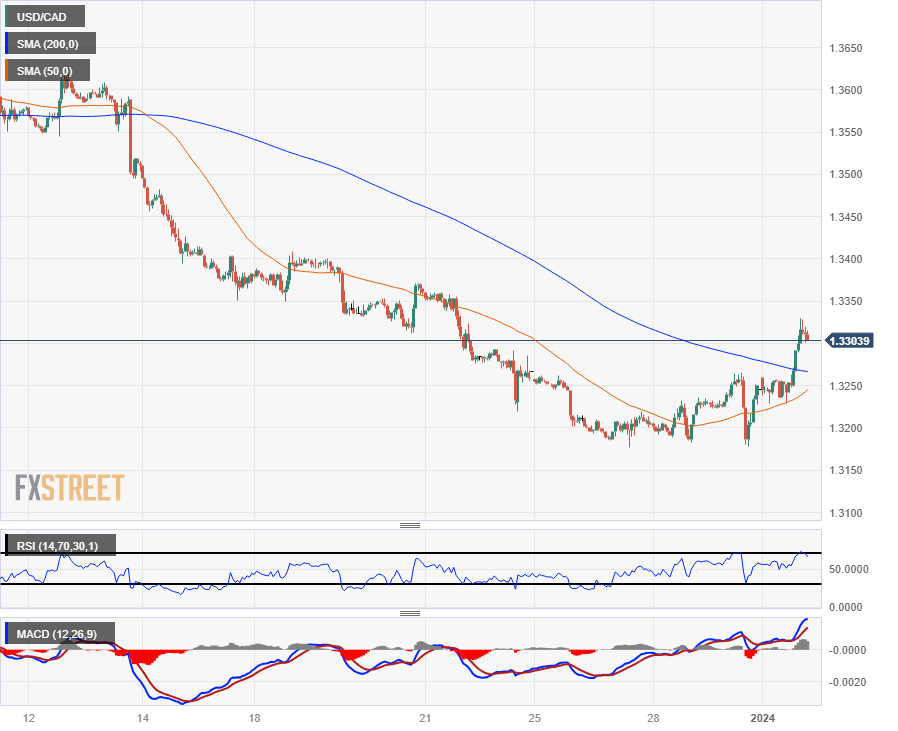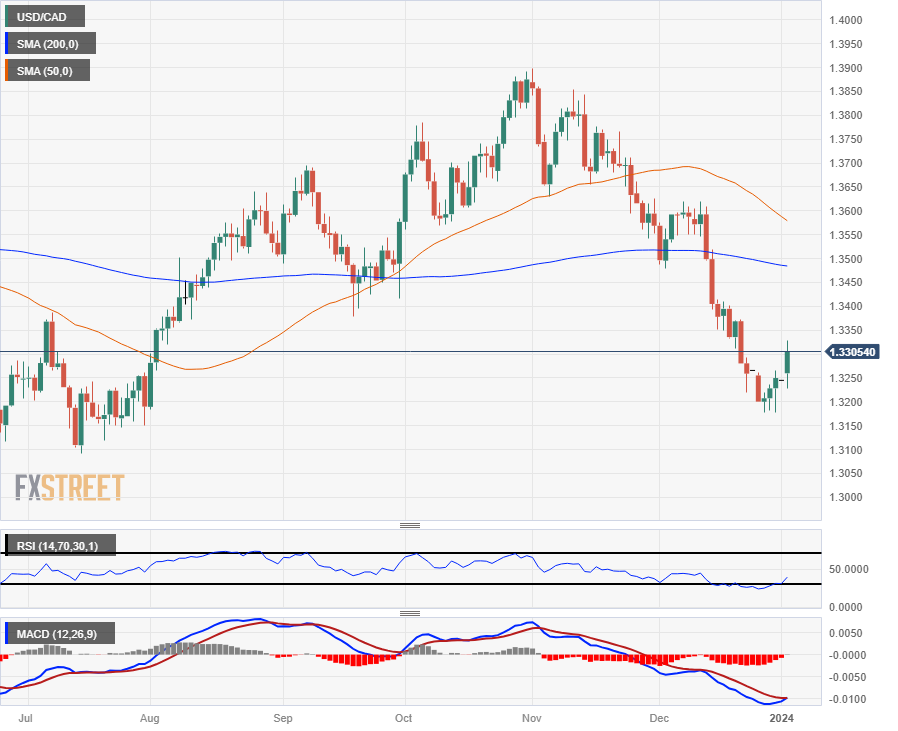- Phân tích
- Tin tức và các công cụ
- Tin tức thị trường
- Canadian Dollar extends declines against Greenback on softer PMI data, weaker Crude Oil
Canadian Dollar extends declines against Greenback on softer PMI data, weaker Crude Oil
- Canadian Dollar falls back as broader markets reverse into Greenback bids.
- Canada economic data continues to slump, Manufacturing PMI flubs expectations.
- Crude Oil continues to slip, dragging down the Loonie.
The Canadian Dollar (CAD) continues to ease back as the 2024 trading year gets underway, extending near-term declines against the US Dollar (USD) to fall a full percentage point as the first trading week of the new year gets underway.
The Canadian S&P Global Manufacturing Purchasing Managers’ Index (PMI) accelerated declines on Tuesday to print at a 43-month low as the Canadian economic outlook continues to deteriorate. The US Manufacturing PMI component also printed below expectations, keeping market risk appetite pinned on the low side and propping up the US Dollar on risk aversion.
Daily digest market movers: Crude Oil, risk aversion bite down on the Canadian Dollar as data misses the mark
- The Canadian Dollar is slipping back against the US Dollar as markets bid up the safe haven Greenback.
- The Canadian Manufacturing PMI printed a multi-year low of 45.4 in December, declining from November’s 47.7.
- The US Manufacturing PMI for December also missed the mark on Tuesday, printing at a four-month low of 47.9. The US PMI missed the market’s expectation of a steady reading from November’s 48.2.
- US Construction Spending also slumped in November, growing by a scant 0.4% versus the market forecast of 0.5%, though October’s MoM Construction Spending print saw a steep late revision from 0.6% to 1.2%.
- Markets have begun to walk back their previous sky-high bets of Federal Reserve (Fed) rate cuts through 2024, with money markets pricing in a median of 150 basis points of rate cuts by year-end.
- US data features heavily on the economic calendar this week, with 2024’s inaugural trading week rounding out the action with Friday’s US Nonfarm Payrolls (NFP).
- Wednesday brings US ISM Manufacturing PMI figures for December, forecast to tick upwards from 46.7 to 47.1, to be closely followed by the Fed’s Meeting Minutes from the latest Open Market Committee meeting.
- Thursday sees the US ADP Employment Change for December, forecast to rise from 103K to 115K, but the recently-inconsistent ADP preview is unlikely to match Friday’s NFP print.
- Friday sees December’s Canadian Unemployment Rate and annualized Canadian Average Hourly Wages, with Canadian unemployment expected to tick higher from 5.8% to 5.9% in December.
- Canadian Friday data can be expected to get overshadowed by US NFP figures, which are forecast to rebound from November’s 199K print to 168K in December.
US Dollar price this week
The table below shows the percentage change of US Dollar (USD) against listed major currencies this week. US Dollar was the strongest against the Swiss Franc.
| USD | EUR | GBP | CAD | AUD | JPY | NZD | CHF | |
| USD | 0.92% | 0.75% | 0.42% | 0.52% | 0.65% | 0.88% | 1.02% | |
| EUR | -0.78% | -0.01% | -0.35% | -0.25% | -0.26% | 0.11% | 0.21% | |
| GBP | -0.76% | 0.01% | -0.32% | -0.24% | -0.02% | 0.13% | 0.20% | |
| CAD | -0.42% | 0.34% | 0.53% | 0.08% | 0.22% | 0.45% | 0.56% | |
| AUD | -0.54% | 0.23% | 0.22% | -0.13% | -0.07% | 0.34% | 0.44% | |
| JPY | -0.64% | 0.29% | 0.18% | -0.03% | 0.05% | 0.43% | 0.31% | |
| NZD | -0.89% | -0.13% | -0.14% | -0.47% | -0.35% | -0.41% | 0.06% | |
| CHF | -0.97% | -0.21% | -0.21% | -0.53% | -0.42% | -0.34% | -0.06% |
The heat map shows percentage changes of major currencies against each other. The base currency is picked from the left column, while the quote currency is picked from the top row. For example, if you pick the Euro from the left column and move along the horizontal line to the Japanese Yen, the percentage change displayed in the box will represent EUR (base)/JPY (quote).
Technical Analysis: Canadian Dollar slips back from multi-month highs in early 2024
The Canadian Dollar (CAD) has shed around a full percent from Tuesday’s peak bids against the US Dollar, easing back from a 21-week peak and sending the USD/CAD pair rebounding from last week’s lows just below 1.3200.
The USD/CAD has climbed back over the 200-hour Simple Moving Average (SMA) for the first time since mid-December when the pair declined over 3% peak-to-trough from the 1.3600 region.
Despite a near-term rebound in the Greenback, the USD/CAD remains firmly planted in bear country with price action well below the 200-day SMA near the 1.3500 major handle, but the technical outlook favors bidders heading into the new trading year. Technical indicators are pinned firmly into oversold conditions, with both the Relative Strength Index (RSI) and the Moving Average Convergence-Divergence (MCAD) signaling ripe buying conditions as the indicators roll over.
USD/CAD Hourly Chart

USD/CAD Daily Chart

Canadian Dollar FAQs
What key factors drive the Canadian Dollar?
The key factors driving the Canadian Dollar (CAD) are the level of interest rates set by the Bank of Canada (BoC), the price of Oil, Canada’s largest export, the health of its economy, inflation and the Trade Balance, which is the difference between the value of Canada’s exports versus its imports. Other factors include market sentiment – whether investors are taking on more risky assets (risk-on) or seeking safe-havens (risk-off) – with risk-on being CAD-positive. As its largest trading partner, the health of the US economy is also a key factor influencing the Canadian Dollar.
How do the decisions of the Bank of Canada impact the Canadian Dollar?
The Bank of Canada (BoC) has a significant influence on the Canadian Dollar by setting the level of interest rates that banks can lend to one another. This influences the level of interest rates for everyone. The main goal of the BoC is to maintain inflation at 1-3% by adjusting interest rates up or down. Relatively higher interest rates tend to be positive for the CAD. The Bank of Canada can also use quantitative easing and tightening to influence credit conditions, with the former CAD-negative and the latter CAD-positive.
How does the price of Oil impact the Canadian Dollar?
The price of Oil is a key factor impacting the value of the Canadian Dollar. Petroleum is Canada’s biggest export, so Oil price tends to have an immediate impact on the CAD value. Generally, if Oil price rises CAD also goes up, as aggregate demand for the currency increases. The opposite is the case if the price of Oil falls. Higher Oil prices also tend to result in a greater likelihood of a positive Trade Balance, which is also supportive of the CAD.
How does inflation data impact the value of the Canadian Dollar?
While inflation had always traditionally been thought of as a negative factor for a currency since it lowers the value of money, the opposite has actually been the case in modern times with the relaxation of cross-border capital controls. Higher inflation tends to lead central banks to put up interest rates which attracts more capital inflows from global investors seeking a lucrative place to keep their money. This increases demand for the local currency, which in Canada’s case is the Canadian Dollar.
How does economic data influence the value of the Canadian Dollar?
Macroeconomic data releases gauge the health of the economy and can have an impact on the Canadian Dollar. Indicators such as GDP, Manufacturing and Services PMIs, employment, and consumer sentiment surveys can all influence the direction of the CAD. A strong economy is good for the Canadian Dollar. Not only does it attract more foreign investment but it may encourage the Bank of Canada to put up interest rates, leading to a stronger currency. If economic data is weak, however, the CAD is likely to fall.
© 2000-2024. Bản quyền Teletrade.
Trang web này được quản lý bởi Teletrade D.J. LLC 2351 LLC 2022 (Euro House, Richmond Hill Road, Kingstown, VC0100, St. Vincent and the Grenadines).
Thông tin trên trang web không phải là cơ sở để đưa ra quyết định đầu tư và chỉ được cung cấp cho mục đích làm quen.
Giao dịch trên thị trường tài chính (đặc biệt là giao dịch sử dụng các công cụ biên) mở ra những cơ hội lớn và tạo điều kiện cho các nhà đầu tư sẵn sàng mạo hiểm để thu lợi nhuận, tuy nhiên nó mang trong mình nguy cơ rủi ro khá cao. Chính vì vậy trước khi tiến hành giao dịch cần phải xem xét mọi mặt vấn đề chấp nhận tiến hành giao dịch cụ thể xét theo quan điểm của nguồn lực tài chính sẵn có và mức độ am hiểu thị trường tài chính.
Sử dụng thông tin: sử dụng toàn bộ hay riêng biệt các dữ liệu trên trang web của công ty TeleTrade như một nguồn cung cấp thông tin nhất định. Việc sử dụng tư liệu từ trang web cần kèm theo liên kết đến trang teletrade.vn. Việc tự động thu thập số liệu cũng như thông tin từ trang web TeleTrade đều không được phép.
Xin vui lòng liên hệ với pr@teletrade.global nếu có câu hỏi.















